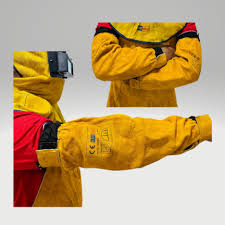Welding sleeves are essential protective gear for anyone involved in welding. They not only provide protection from sparks, spatter, and radiant heat but also help prevent burns and injuries. In this step-by-step welding sleeve guide, we will walk you through putting on a welding sleeve and using welding sleeves to ensure your safety and comfort during welding tasks.
Welding sleeves are designed to protect the arms from the hazards of welding. They are typically made from fire-resistant materials such as leather, Kevlar, or specialized welding fabrics. These sleeves extend from the wrist to the upper arm, providing a barrier against heat, sparks, and UV radiation.
Choosing the Right Welding Sleeves
Before looking into the step-by-step welding sleeve guide , choosing the right type of welding sleeves for your needs is important. Here are some factors to consider:
1. Material
Choose a material that suits your welding type. Leather is durable and offers excellent protection, while Kevlar is lightweight and highly heat-resistant.
2. Size
Ensure the sleeves fit properly. They should cover the arm from the wrist to the bicep without being too tight or too loose.
3. Comfort
Look for features like adjustable straps or elastic bands that ensure a snug fit without restricting movement.
Step-by-Step Guide to Putting On Welding Sleeves
Welding sleeves protect your arms from sparks, heat, and molten metal. Properly donning them is crucial for maximum protection. This step-by-step welding sleeve guide will help you put on welding sleeves correctly, ensuring safety and comfort during welding tasks.
Preparation
Inspect the Sleeves
Before using welding sleeves, inspect them for any signs of damage, such as tears or burns. Replace any damaged sleeves immediately.
Cleanliness
Ensure the sleeves are clean and free from contaminants that could compromise their protective qualities.
Donning the Sleeves
Position Yourself
Stand in a comfortable position with your arms relaxed.
Start with the Dominant Arm
Slip the welding sleeve onto your dominant arm first. This allows for better control and ease of adjustment.
Slide the Sleeve Up
Gently slide the Sleeve up your arm, ensuring it covers the wrist and forearm and reaches the upper arm or shoulder area. The Sleeve should fit snugly but comfortably.
Adjust the Fit
Use any available straps, Velcro, or elastic bands to adjust the fit. The Sleeve should be secure without being restrictive, allowing for free movement.
Securing the Sleeves
Check for Gaps
Ensure no gaps between the Sleeve and your gloves or other protective gear. Gaps can allow sparks or hot metal to reach your skin.
Double-Check the Fit
Flex your arm and move it around to ensure the Sleeve stays in place and does not shift during movement.
Repeat for the Other Arm
Don the Second Sleeve
Repeat the process for your other arm, ensuring the same level of fit and security.
Final Adjustments
Make final adjustments to both sleeves, ensuring they are secure and comfortable.
Maintenance and Care of Welding Sleeves
Regular Inspection
After Each Use
Inspect the sleeves for any damage or wear after each use. Look for signs of burns, tears, or material degradation.
Periodic Replacement
Replace sleeves that show significant wear or damage to ensure continuous protection.
Cleaning
Follow Manufacturer's Instructions
Clean the sleeves according to the manufacturer's welding sleeve instructions. Some materials may require specific cleaning methods.
Avoid Harsh Chemicals
Use mild detergents and avoid harsh chemicals that could weaken the material.
Storage
Dry Storage
Store welding sleeves in a dry, cool place away from direct sunlight. Moisture and UV rays can degrade the material over time.
Organized Storage
Keep sleeves organized and easily accessible. Avoid folding or creasing them in a way that could compromise their integrity.
Tips for Properly Using and Maintaining Welding Sleeves
Properly using and maintaining these sleeves is crucial for ensuring both safety and longevity. Here are some welding sleeve safety tips to help you get the most out of your welding sleeves, ensuring they provide optimal protection and remain in excellent condition over time.
Choose the Right Material
Select welding sleeves made from materials that suit the intensity of your welding tasks. Leather is ideal for high-heat environments, while Kevlar is suitable for lightweight, flexible protection.
Ensure a Snug Fit
The sleeves should fit snugly without being too tight. This ensures maximum protection while allowing free movement.
Cover All Exposed Skin
Make sure the sleeves cover your wrist and your upper arm. Overlap the sleeves with your gloves to avoid any gaps where sparks could enter.
Adjust as Needed
Secure the sleeves with adjustable straps, Velcro, or elastic bands. Regularly check and adjust them to maintain a good fit throughout your work session.
Check for Mobility
After wearing the sleeves, move your arms around to ensure they do not restrict your movements or cause discomfort.
Stay Aware
Periodically check your sleeves' position during welding to ensure they haven't shifted, exposing your skin.
Layer for Extra Protection
Consider wearing a fire-resistant long-sleeve shirt under your welding sleeves for additional protection for tasks involving intense heat or extended welding periods.
Maintenance Tips
Proper maintenance of welding sleeves is essential for their protection and longevity. By following best welding sleeves practices, you can keep your sleeves in excellent condition for all welding tasks.
Regular Inspection
Before each use, inspect the sleeves for signs of wear, tear, or damage. If any issues are found, replace them.
Clean Properly
Follow the manufacturer's instructions for cleaning. Use mild detergents and avoid harsh chemicals that could weaken the material.
Store Correctly
Store welding sleeves in a cool, dry place away from direct sunlight. Proper storage helps maintain the material's integrity and prolongs the sleeves' lifespan.
Avoid Moisture
Ensure sleeves are completely dry before storing them to prevent mold or material degradation.
Replace When Needed
Regularly replace sleeves to ensure they provide optimal protection. Keep spare sleeves available so you can quickly replace damaged ones.
Avoid Folding
Store sleeves flat or gently rolled to avoid creases that could weaken the material over time.
Stay Updated on Best Practices
Keep informed about the latest welding safety standards and practices. Regularly review and update your PPE to ensure it meets current safety requirements.
Following these welding sleeve safety tips ensures that your welding sleeves offer maximum protection and last longer, contributing to a safer and more comfortable welding experience.
Conclusion
Using welding sleeves correctly ensures safety and comfort during welding tasks. By following this step-by-step welding sleeve guide, you can ensure that your welding sleeves provide the maximum protection against the hazards of welding. Regular inspection, proper fit, and adherence to safety precautions are vital to maintaining the effectiveness of your welding sleeves. Always prioritize safety and comfort to achieve the best results in your welding projects.
Strongarm is the leading welding manufacturer and provider in America. We have a team of trusted professional welders offering a wide range of welding aprons and gears to suit your needs. Contact us today for all your weldings essentials.






